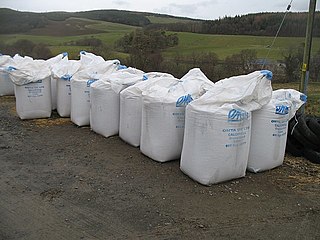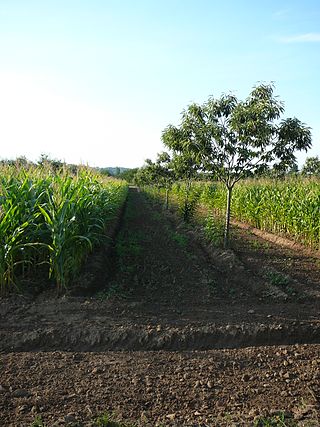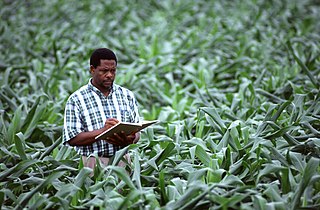
Agricultural science is a broad multidisciplinary field of biology that encompasses the parts of exact, natural, economic and social sciences that are used in the practice and understanding of agriculture. Professionals of the agricultural science are called agricultural scientists or agriculturists.

Agriculture encompasses crop and livestock production, aquaculture, fisheries and forestry for food and non-food products. Agriculture was the key development in the rise of sedentary human civilization, whereby farming of domesticated species created food surpluses that enabled people to live in cities. While humans started gathering grains at least 105,000 years ago, nascent farmers only began planting them around 11,500 years ago. Sheep, goats, pigs and cattle were domesticated around 10,000 years ago. Plants were independently cultivated in at least 11 regions of the world. In the twentieth century, industrial agriculture based on large-scale monocultures came to dominate agricultural output.

Intensive agriculture, also known as intensive farming, conventional, or industrial agriculture, is a type of agriculture, both of crop plants and of animals, with higher levels of input and output per unit of agricultural land area. It is characterized by a low fallow ratio, higher use of inputs such as capital, labour, agrochemicals and water, and higher crop yields per unit land area.

Sustainable agriculture is farming in sustainable ways meeting society's present food and textile needs, without compromising the ability for current or future generations to meet their needs. It can be based on an understanding of ecosystem services. There are many methods to increase the sustainability of agriculture. When developing agriculture within sustainable food systems, it is important to develop flexible business process and farming practices. Agriculture has an enormous environmental footprint, playing a significant role in causing climate change, water scarcity, water pollution, land degradation, deforestation and other processes; it is simultaneously causing environmental changes and being impacted by these changes. Sustainable agriculture consists of environment friendly methods of farming that allow the production of crops or livestock without damage to human or natural systems. It involves preventing adverse effects to soil, water, biodiversity, surrounding or downstream resources—as well as to those working or living on the farm or in neighboring areas. Elements of sustainable agriculture can include permaculture, agroforestry, mixed farming, multiple cropping, and crop rotation.
Agroecology is an academic discipline that studies ecological processes applied to agricultural production systems. Bringing ecological principles to bear can suggest new management approaches in agroecosystems. The term can refer to a science, a movement, or an agricultural practice. Agroecologists study a variety of agroecosystems. The field of agroecology is not associated with any one particular method of farming, whether it be organic, regenerative, integrated, or industrial, intensive or extensive, although some use the name specifically for alternative agriculture.

Agriculture is a major industry in the United States, which is a net exporter of food. As of the 2017 census of agriculture, there were 2.04 million farms, covering an area of 900 million acres (1,400,000 sq mi), an average of 441 acres per farm.
Biodynamic agriculture is a form of alternative agriculture based on pseudo-scientific and esoteric concepts initially developed in 1924 by Rudolf Steiner (1861–1925). It was the first of the organic farming movements. It treats soil fertility, plant growth, and livestock care as ecologically interrelated tasks, emphasizing spiritual and mystical perspectives.

Liming is the application of calcium- (Ca) and magnesium (Mg)-rich materials in various forms, including marl, chalk, limestone, burnt lime or hydrated lime to soil. In acid soils, these materials react as a base and neutralize soil acidity. This often improves plant growth and increases the activity of soil bacteria, but oversupply may result in harm to plant life. Modern liming was preceded by marling, a process of spreading raw chalk and lime debris across soil, in an attempt to modify pH or aggregate size. Evidence of these practices dates to the 1200's and the earliest examples are taken from the modern British Isles.

Agroforestry refers to any of a broad range of land use practices where pasture or crops are integrated with trees and shrubs. This intentional combination of agriculture and forestry has multiple benefits, such as greatly enhanced yields from staple food crops, enhanced farmer livelihoods from income generation, increased biodiversity, improved soil structure and health, reduced erosion, and carbon sequestration. Trees in agroforestry systems can also produce wood, fruits, nuts, and other useful products with economic and practical value. Agroforestry practices are especially prevalent in the tropics, especially in subsistence smallholdings areas with particular importance in sub-Saharan Africa. However, due to its multiple benefits, for instance in nutrient cycle benefits and potential for mitigating droughts, it has been adopted in the USA and Europe.

An agriculturist, agriculturalist, agrologist, or agronomist, is a professional in the science, practice, and management of agriculture and agribusiness. It is a regulated profession in Canada, India, the Philippines, the United States, and the European Union. Other names used to designate the profession include agricultural scientist, agricultural manager, agricultural planner, agriculture researcher, or agriculture policy maker.
Harold F. Reetz Jr. was an American agronomist.

The University of Wisconsin–Madison College of Agricultural and Life Sciences is one of the colleges of the University of Wisconsin–Madison. Founded in 1889, the college has 17 academic departments, 23 undergraduate majors, and 49 graduate programs.

The Indian Institute of Soil Science is an autonomous institute for higher learning, established under the umbrella of Indian Council of Agricultural Research (ICAR) by the Ministry of Agriculture, Government of India for advanced research in the field of soil sciences.
John Jacob Mortvedt was an American soil scientist who worked with micronutrient fertilizer.
Leslie Denis Swindale was a New Zealand-born soil scientist, agriculturist, writer and a former chairman of the Department Agronomy and Soil Science of the University of Hawaii. He was the author of several books on soil and agricultural sciences and was a part of the Freedom from Hunger Campaign of the Food and Agriculture Organization. He was a Fellow of New Zealand Institute of Chemistry, American Society of Agronomy and a foreign fellow of the National Academy of Agricultural Sciences. The Government of India awarded him the third highest civilian honour of the Padma Bhushan, in 1991, for his contributions to science, making him one of the few non-Indians to receive the award.
Cynthia Grant is a former Canadian federal scientist who is an expert in soil fertility and crop nutrition. She was a researcher with Agriculture and Agri-Food Canada (AAFC) (1986-2015). Her research provided the scientific foundation for the Made-in-Canada 4R nutrient stewardship framework that applies crop nutrients from the right source and at the right rate, time and place. Grant is now part of an elite group of ten women who have been inducted into the Canadian Agricultural Hall of Fame since 1960.
Oregon Agricultural Experiment Station (OAES) is affiliated with Oregon State University and coordinates research at experiment stations in Oregon. It receives state funding and funding from contracts for its work. It has 11 branch stations. It was established in 1887 after passage of the Hatch Act of 1887 and began at Oregon Agricultural College in 1888. It publishes a station bulletin. It also produced films and public service announcements. Rural homemaking practices were studied when female researchers were added to the organization. Publication topics have included studies on soils, pests, and crops.
Guy Lafond was a research scientist for over 30 years with Agriculture and Agri-Food Canada at the Indian Head Research Farm in Saskatchewan. He was instrumental in establishing the Indian Head Agricultural Research Foundation (IHARF) in the early 1990s and had a major impact on cropping practices and soil conservation.
Te May Ching (1923-2020) was a seed physiologist and worked for the OSU Crop Science Department from 1956 until her retirement in 1988.
Elizabeth Lee "Betty" Klepper was an American agronomic scientist from Memphis, Tennessee.








